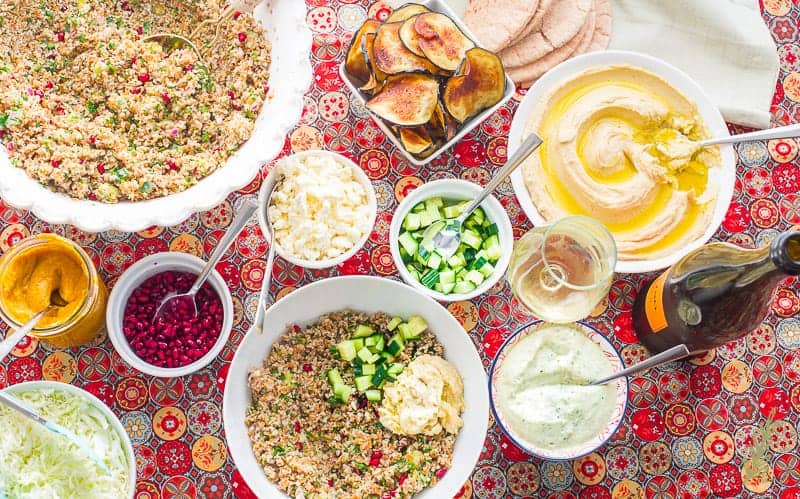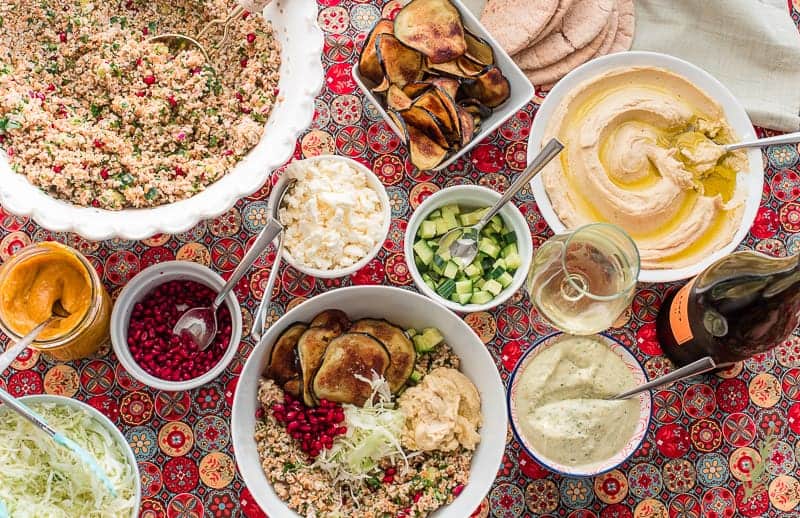
What is a Sabich Bowl?
Sabich is a decidedly Jewish sandwich, created, and brought to Israeli, by an Iraqi Jew. The sandwich was created to sustain Jews through the Sabbath (as there is no cooking allowed on their holy day). The sandwiches are filled with fried eggplant slices and an egg hard-boiled in Cholent, a traditional beef and barley stew. Sabich sandwiches aren’t one of the neatest foods I’ve eaten- I found that to be so after my first bite of one. My dear friend, Abergil, introduced me to sabich in NYC. Customizing my sandwich, and thereby loading it down with toppings, was all fun and games until it was time to take a bite. Veteran sabich eaters know there’s an unspoken stance to assume when going in for the kill. I was still wet behind the ears. A second sandwich was purchased after my first met its doom on the Brooklyn sidewalk.
Since I’m not a fan of high-maintence eating, I decided to create a neater sabich. A bowl was introduced into the fray and I kept all of my favorite ingredients. Even the pita remained, it was just…well, not as annoying.
What ingredients go into Sabich Bowls?

How do I make eggplant for Sabich Bowls?

First, I cut the end of the eggplant off to get rid of any woody stems, or leaves. If you have a mandoline feel free to use that to cut your slices. Me? I’m an old-fashioned type of chick so my chef’s knife is all I need.
Cut your eggplant into very thin (about an eight of an inch thick) slices. Don’t worry too much if they’re not perfectly uniform, you just don’t want extreme differences in the thickness of the slices.

How long do I fry my eggplant chips?
Once you’re all prepped, drop an eggplant slice into your oil. This will be your test slice to see about how long the frying time should be. Since slices may vary, you need a general guide before you start frying up the batches. This will go pretty quickly because of how thin they are. After about a minute, or two, flip the slice to fry the other side. The total frying time should be no longer than five minutes, or until golden brown. Once you have determined your approximate frying time, drop a few slices of eggplant into the oil. Try not to crowd your pan as that lowers the temperature and causes the slices to boil in oil, rather than fry.

Before your next batch is removed from the oil, salt the slices that are currently draining on the sheet pan. Transfer the salted slices to a holding dish for adding to the sabich bowls later. Continue frying, draining, and salting until all of the eggplant slices are cooked.
What other foods go into Sabich Bowls?
In between frying the batches of eggplant slices, bring a large pot of water to a boil. As soon as the water reaches a boil, carefully lower your eggs into the water and simmer for nine minutes. You’ll need as many eggs as people you are serving. For my family of four, I typically serve two boiled eggs per bowl, which means I hard-boil eight eggs. If you don’t have egg-lovers, one egg per person is fine. After nine minutes, drain the water from the pot and refill it with cold water. Allow the eggs to cool for ten minutes before peeling.
Obviously, in order to keep this a vegan bowl, you’ll need to omit the boiled eggs.
What type of grains do I use in my Sabich Bowl?
Now for the fun part; it’s time to assemble our sabich bowls! Like I mentioned earlier, the great thing about this recipe is how customizable and easy it is to put together. You can purchase your accompaniments pre-made, or make your own using the links below. I’m sure you know which I’d recommend, but I understand that life is real thing. No matter which route you take, make sure you’re using high-quality ingredients to build your bowls.
Obviously, the first thing you’ll need are your bowls. One bowl per person, unless you’re all romantical and whatnot. Hector and I don’t play when it comes to our food, so we don’t get down with that sharing mess. He gets his, I gets mine, and the Twinks get theirs. That’s how we prevent domestic disturbances up in here.
Start with your grain. My grain of choice for these sabich bowls is my Tabbouleh (Bulgur Parsley Salad). Typically, I make my tabbouleh with twice the amount of parsley; however, if I know I’m going to use it in my sabich bowls, I use a lighter herb hand. One to one-and-a-half cups of tabbouleh is perfect for each bowl.
Some other grain ideas for your bowls are:
- couscous
- white or brown rice
- farro
- quinoa
How about Spreads?

What type of veggies work best in Sabich Bowls?

Other items that are great for crunch are:
- jicama
- carrots
- onions
- sweet peppers
- toasted nuts

I don’t like cabbage. What do I replace it with?

Here are some alternatives to shredded cabbage:
- shredded iceberg or romaine
- baby spinach leaves
- microgreens
- shredded purple cabbage
What other topping work well in Sabich Bowls?
To switch things up, add a pop of color and texture with pomegranate arils! These are now available in the produce aisle all ready to go. I use these in place of diced tomatoes for their sweetness and crunch.
Some substitutes are:
- diced tomatoes
- sliced sweet peppers
- diced granny smith apples
- sliced grapes
What sauces do I drizzle over Sabich Bowls?
Tahini Sauce is a must for sabich and as is feta. While you could buy your tahini sauce from the store, my recipe is ready in five minutes which means making it at home is a lot faster. Feta is a salty, briny cheese that is very popular in Middle Eastern dishes. If you want to try something different, labneh (another Middle Eastern cheese) is a great substitute. You can also omit the cheese altogether and make this a vegan dish.
Now, we can’t go forgetting our hard-boiled eggs! Slice them up, cut them in half, or leave them whole- it’s up to you. Add one or two eggs to each bowl.
The final, and most exciting, ingredient (at least for me) is Amba Sauce. Amba is a pickled mango chutney. My sabich bowls are heavily-doused with this stuff; it’s that good. It gives the bowl a sweet-savory-umami vibe that just has to be experienced at least once in everyone’s lives. You can purchase it, but once again, making it results in more flavor and enjoyment.
I don’t have time to make Falafel. What substitutes do I use?
The last addition to my sabich bowls are my Egyptian Falafel. If you just have to stay true to the Israeli theme, you can make these falafel with chickpeas instead of fava beans. I don’t mind shaking things up a bit, so these fried fava patties are going in mine.
If you want to sub out the falafel try:
- fried firm tofu
- diced cooked chicken breast
- lamb meatballs
- grilled salmon
Is there anything else I can serve with my Sabich Bowls?
All you need now is a side dish filled with toasted pita bread!

There’s nothing better for large crowds of people than these bowls. Set out all of your ingredients and let your family and friends customize their own bowls. Pin this recipe for your next Spring or Summer soiree and share it with your friends and family!

Sabich Bowls
at Sense & EdibilityIngredients
- 1 large eggplant thinly sliced
- kosher salt to taste
- vegetable oil for frying
- 6 cups Tabbouleh homemade or store-bought prepared
- 2 cups Hummus homemade or store-bought
- 2 cups pomegranate arils
- 1 cucumber diced
- 2 cups (6 oz) green cabbage shredded
- 2 cups Tahini Sauce homemade or store-bought
- 8 oz feta cheese crumbled (omit for vegan recipes)
- 4 hardboiled eggs optional (omit for vegan recipes)
- 2- 2 1/2 cups Amba Sauce homemade or store-bought
- 16 Falafel or 2lbs cooked protein, diced
- pita bread to serve
Instructions
Fry the Eggplant Chips
- In a large frying pan, heat the oil over med-high heat. A deep-fat frying thermometer should read 350°-375°F. Prepare a draining station by lining a sheet pan with a layer of absorbent paper towels.
- Fry the eggplant slices in small batches for 3-4 minutes, or until golden brown. Flip the slices while frying to avoid frying the slices unevenly. The total frying time should be no longer than five minutes.
- Transfer the fried eggplant slices from the pan using a pair of tongs or a slotted spoon. Salt the slices that are draining on the sheet pan. Transfer the salted slices to a bowl. Continue frying, draining, and salting until all of the eggplant slices are cooked.
Assemble the Sabich Bowls
- Add one to 1 1/2 cups of Tabbouleh (Bulgur Parsley Salad) to each bowl.
- Scoop a 1/2-1 cup of Middle Eastern Hummus.
- Follow with the a generous handful of the fried eggplant slices, 1/2 cup of pomegranate arils, 1/4 of diced cucumber, and 1/2 cup of shredded cabbage.
- Pour a 1/2 of Tahini Sauce onto each prepared bowl and sprinkle a 1/4 cup of crumbled feta cheese on top of each.
- Slice the hard-boiled eggs (if using) and add one or two to each bowl. Top each bowl with a 1/2 cup of Amba Sauce.
- Finally, add four pieces of Egyptian Falafel to each bowl. Serve with a side of toasted pita bread and enjoy!
Nutrition
**This post contains affiliate links. To find out what that means to you, please read my disclosure page**
Can’t get enough of ethnic recipes? Try these out:
Hibiscus, Blood Orange & Cardamom Paletas
Vegetarian Curried Cauliflower















I have never heard of Sabich, but I will definitely have to try this. I love falafel and love new ways to incorporate them into different dishes.
You’ll definitely love this then, Ayanna!